Archive Section
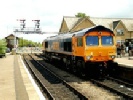

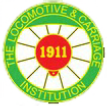

17th March 2011
© Text by Tom Chaffin, photo credits below each photo.
Click images for a enlarged view
As the entrance to Hornsey Depot is just off the end of Hornsey station footbridge 12 members of the Institution gathered on the footbridge prior to our evening visit to Hornsey Depot.
We were met at the depot entrance by Richard Farish (Operations Standards Development Manager).
Hornsey Depot from footbridge
© Amanda Fox
Just inside the entrance to Hornsey depot we were greeted with the sight of a bogie-
After original use of the converted carriage had ceased it was purchased by First Group and moved to Hornsey. It now needs further work to be carried out on it if it is to continue to be used for training. First Group are seeking funding from the wider railway community as potentially the carriage could be used to the benefit of others in the industry
Hornsey Depot
Hornsey Depot was extensively rebuilt in 1975 as part of the Great Northern Electrification scheme, though some parts of the original Great Northern Railway depot remain.
The following trains are maintained at Horney:
|
Class 313 |
The original inner suburban units dating from the Great Northern electrification in the mid 1970s. Dual voltage AC/DC |
|
Class 317 |
Outer suburban units dating from the early 1980s. AC only. |
|
Class 319 |
Dual- |
|
Class 321 |
A small quantity of these units dating from the late 1980s have recently been cascaded to the Great Northern route and mainly work services to Peterborough. AC only |
|
Class 365 |
Part of the Networker family of units from the early 1990s which work outer- |
|
Class 377 |
These new units from the Thameslink route have their tires turned at Hornsey. Dual voltage AC/DC |
Depot roads 18 & 19 are used for train cleaning as our visit was during the evening peak these were empty at the time of our visit.
However, new roads are being built for train cleaning outside of the main shed so as to free space in the main shed for train maintenance. This work is being funded by the DfT in order to equip the depot for extra work for the forthcoming May 2011 timetable change. The new roads will have high platforms and canopies for weather protection. They will also be equipped with cleaning points and water supplies.
Depots road 20 to 23 are used for train maintenance.
Hornsey depot is equipped with jacks able to lift carriages up to 23m in length a whole unit can be lifted simultaneously, though more normally one carriage is lifted at a time.
In the maintenance area, mobile roller-
For each depot road the 25kV OLE can be isolated independently so that the train it that road can be safely worked on. Fall-
The depot is at its busiest between 19.00 and 06.00hrs. At the end of the days rush hour trains progressively arrive at the depot for overnight cleaning and maintenance from around 19.00.
Train Exams
Most exams are undertaken on accumulated unit miles A, B & F. A C4 exam which includes bogies and drawgear overhaul is undertaken nominally every four years, though the exact interval depends on miles run by the unit.
A Class 313 has an exam every 4200 miles which is normally after around three to four weeks of operation. Mileage between exams and the normal duration between those exams varies depending on the class of train.
Mobile boards adjacent to the trains detail level 5 overhaul progress for the trains concerned undergoing this activity
Bogies requiring overhaul are sent to Railcare at Wolverhampton for class 313 units and to Bombardier at Crewe for all other units.
In this room was various jigs and test equipment including a jig to test Class 313 camshafts. The jig simulates a train so that correct operation of the camshaft can be fully tested whilst enabling easy access on the bench. Camshafts can be left under test on the jig overnight if they are still working in the morning they should be fit to be refitted to a train. The jig has been used to assist other operators such as London Overground whilst they still used Class 313s.
Mk 2F FO used for train evacuation tests]
© Amanda Fox
Class 313 camshaft tester
© Stuart Smith
Jigs enable the depot to get to the bottom of reliability issues, help predict age-
Class 313 camshaft tester
© Amanda Fox
As train fleets ages problems with component obsolescence increase. Interesting, this is less of an issue with the older 1970s and early 1980s trains compared with those built more recently. On the older trains, whilst supplies of an original part may disappear, it is usually possible to backwards engineer a part so that it can be manufactured by someone else. However, this is not possible with the electronics and now software used on more modern trains. For example, the electronics used on Class 365s units are now causing concern and the installation of new traction equipment to these trains at mid-
There is some commonality of components between units of similar vintage, for example some relays are common between Class 313 and Class 317s.
Wheel Lathe
At the time of our visit the original wheel lathe was still in use. This is only capable of turning a single wheel at a time and requires considerable time to be set-
However when we visited a new German lathe, installed by Network Rail, was nearing completion and was planned to be commissioned by early May 2011. The new lathe includes a battery tug to manoeuvre the trains and will be able to turn multiple wheels at once. The new lathe is computer-
In the meantime the old lathe is being nursed until the new one is available. When the old lathe is decommissioned the building will be refitted with heavy lifting equipment to enable traction motor changes to be carried out.
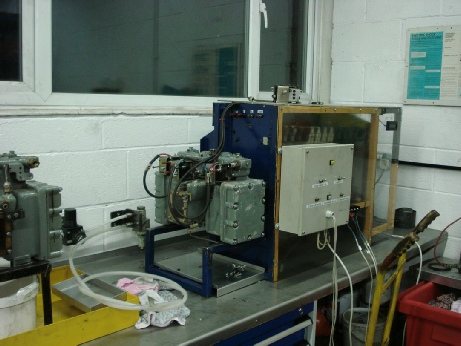
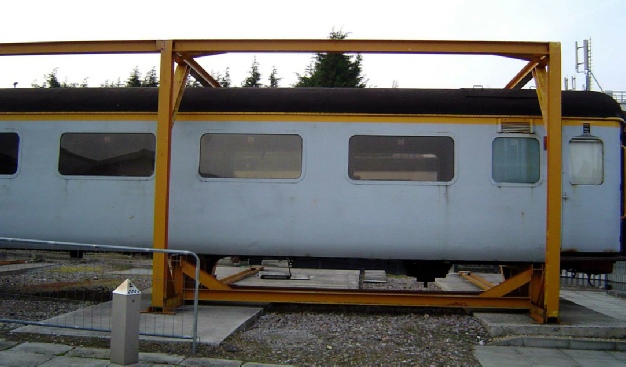
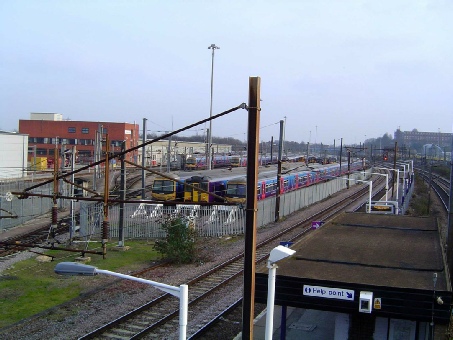
We each had a go at driving both simulators between a number of stations. It was quite noticeable that the Class 365 was significantly nippier than the Class 319, with acceleration notably quicker.
On both trains, there is driver reminder appliance (DRA) button in a prominent position at the top of the dashboard below the windows. This is depressed: when the driver is closing down, entering or leaving the cab or when the driver does not have authority to proceed for example at a red signal. When depressed, the button glows red and prevents traction power being applied. When the driver has authority to proceed the button is pulled outwards extinguishing the light and allowing traction power to be applied. The DRA buttons were mandated after a series of accidents, many caused by the driver being distracted during station duties and then forgetting, or not checking, the signal aspect when the train was ready to depart. The DRA helps prevent this as this button should be realised as the last action the driver undertakes before leaving a station.
For a station departure, as with when driving a real train, when driving the simulator we had to: check the signal is clear; look out of the window at the DOO CCTV monitor bank to check that no passengers are going through the doors; press the door close buttons; hear the door close hustle alarm and watch the doors close and body side orange indicators light extinguish on the DOO CCTV image; check that interlock light on the desk illuminates; cancel DRA, realise brakes and apply power.
A PASSCOM (passenger communication alarm) activation was simulated whilst we were driving the simulator. The touchscreens outside the cab were used to see which coach had the orange bodyside light lit which indicates that it was the coach where the PASSCOM activation was made. Once that coach is selected the applicable coach interior views are then displayed so that the individual PASSCOM alarm can be reset.
Whilst we were driving the simulators we also had to deal with various hazards, such as falling snow, low adhesion, passengers trapped in doors, a broken windscreen and other members of the Institution in the cab giving driving advice!
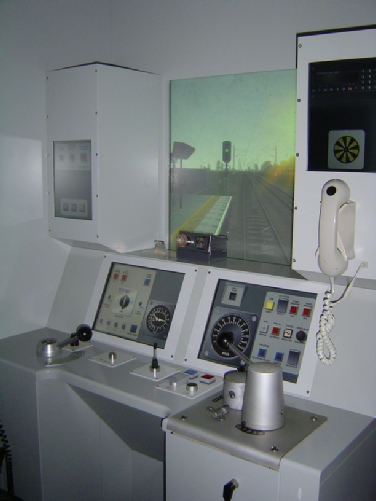
Class 319 Drive Simulator and Control Desk
© Amanda Fox

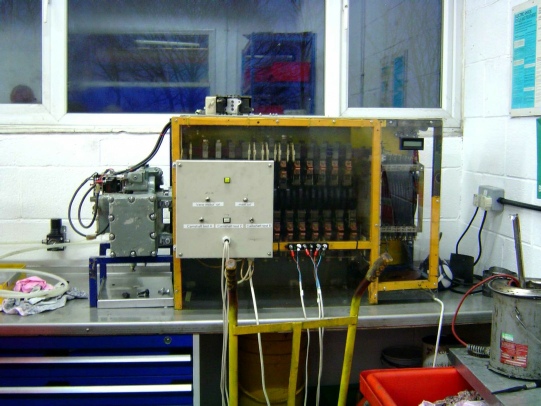
Train Modifications
The fleet has had the First Capital Connect external branding applied following the take-
First-
Blue Room
The blue room, so named due to the colour on the walls, is used to give a quick visual view of depot performance. Each department in the depot has its own board. Examples of boards include those on the status of materials; various projects in progress; a technical issues board showing progress on delivering improvement in reliability to the fleet, a generic depot performance board and a board detailing train fleet performance. The train performance boards shows miles per causality for each train class maintained at Hornsey and is updated weekly.
The Blue Room adjoins the main depot office and some boards can be turned round so as to be visible from either room.
The boards in the room are reviewed every day at 10.00 by the Depot Manager.
Main Office
Next to the blue room was the main depot office, which is occupied by a number of different posts.
The Fleet Managers position is manned over three shifts per day. Amongst other duties they take calls from drivers who are experiencing difficulties with their train which they try and resolve over the phone were possible. Drivers either report faults by their company issued mobile, or can be patched to the depot by the signaller when using Cab Secure Radio, though this can time-
The Operations Manager plans the unit allocations to ensure trains get to the depot when they should for examinations. Train diagramming is based on miles to next exam. For example, if the depot is busy, a unit maybe put on a low mileage diagram so as delay its coming into the depot for an exam by a day or so.
The Shift Fleet Manager organises the maintenance plan for the units. A board on the wall shows the plan for the next seven days.
Servicing and Test Room
As seems to be increasingly the trend, more and more component repair and overhaul works are being undertaken in house by depots rather than by external contractors . As well as improving quality, being able to repair equipment in the depot reduces downtime.
Class 313 with bogie removed -
© Amanda Fox
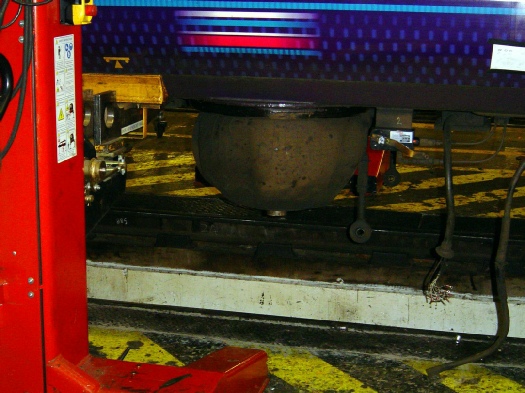
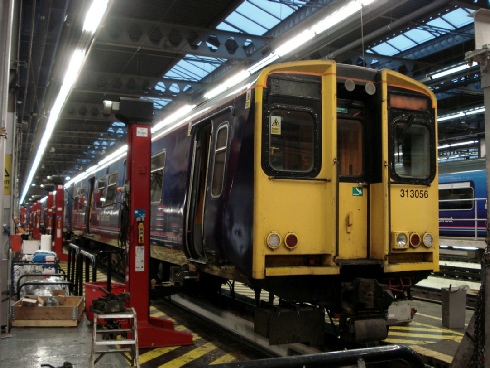
313 056 on the lifting jacks
© Stuart Smith
Stores
The depot stores are housed in the old steam engine shed one of the original parts of the depot still surviving. Battery tugs are used to move bogies and other heavy equipment around the depot.
Depot Shunters:
Two diesel shunters were on the depot at the time of the visit:
03 179 this shunter was formally used on the Isle of Wight and therefore has a cut-
08 750 this 350hp diesel electric shunter was being hired from Wabtec due to problems with the tugs which are normally used to manoeuvre carriages within the depot.
Driving Simulators
After Ladbrook Grove, it was recommended that driving training and assessment was improved using new technologies including driver simulators. First Group was one of four companies to introduce simulators following this recommendation. The tender for the simulators at Hornsey was won by Krauss-
900 thousand was spent on the simulators at Hornsey. The simulators were commissioned in early 2009. The simulators have been well received with the technology and craftsmanship considered excellent Two simulators are installed at Hornsey, one representing a class 319 EMU used on the Thameslink route, the other a class 365 EMU as used on the Great Northern route from Kings Cross to Peterborough and Kings Lynn.
On the class 319, the AC/DC power changeover, which trains on the Thameslink route undertake at Farringdon, can be simulated. The controls on the new classes of unit are significantly different with the class 319 having a separate power and brake controls whereas the class 365 has a combined power and brake controller more on these later. For both classes of train each simulator consists of a very close reproduction of the actual train cab, including the virtually the same dimensions from side to side and from front window to rear bulkhead as the real cab so as to be as realistic as possible. A screen shows the image of the line ahead through the drivers front window and other screens are placed by the cab side windows to show the view the driver would see from these, particularly when using Driver Only Operation CCTV from station monitor banks.
For the auxiliary cab-
New friver training consists of a 22 weeks in the classroom, including time on the simulators. Some 600 drivers have now used the simulators. As well as being used to train new recruits, they are also used to retrain drivers after operational incidents, for training as an aid to understanding of rules and regulations and for the enactment of hazards and their control measures. The simulators are now used as part of drivers bi-
The simulated route consists of 100km of generic route. It is considered best to use a generic route rather than attempt to simulate a real route as if an actual route was used drivers would find inaccuracies with the route and be distracted by this which is not the point of the simulator. Multi, double and single track lines are simulated as well as two, three, four aspect and junction signals. Different weather conditions can also be simulated as well as different light levels depending on the time of day. Additionally, adhesion levels can be varied so that correct braking technics in poor adhesion conditions can be experienced. The simulator includes a comms platform so that the Cab Secure Radio in the cab can be set-
Drivers using the simulators have been seen to wave at simulated trains passing them which is measure of how realistic the simulator is compared to driving a real train!
Train faults and PASSCOM activations on the train can also be simulated. Touchscreens outside of the cab can be used for drivers to isolate cocks etc around a virtual train, which utilises images from actual trains.
In early 2010 signallers from Peterborough Signalling Control Centre had a go at using the simulator to get an appreciation of what the drivers experience. This is going to be repeated for signallers from Kings Cross and West Hampstead Signalling Control Centres.
The Class 319 cab has separate power and brake controllers each consisting of a handle perpendicular to the drivers desk which is moved through an arc. The brake controller is on the drivers left hand side, has four steps: 1, 2, 3 Full Service, 4 Emergency. There is a two minute delay after an emergency brake application before the brakes can be released. The power controller is on the drivers right-
On the Class 365 there is one combined power and brake controller on the drivers left-
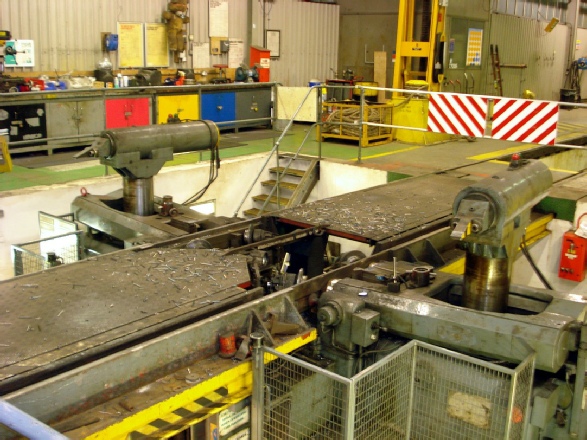
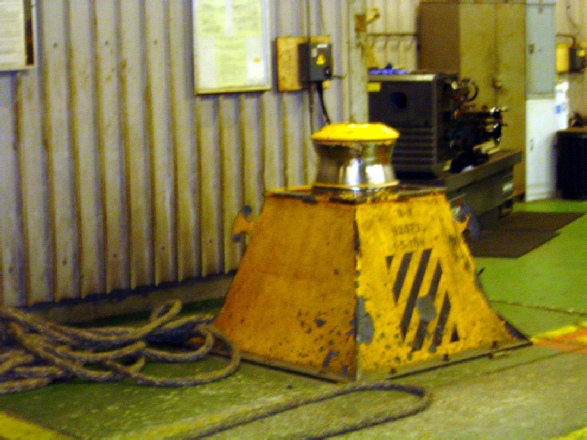
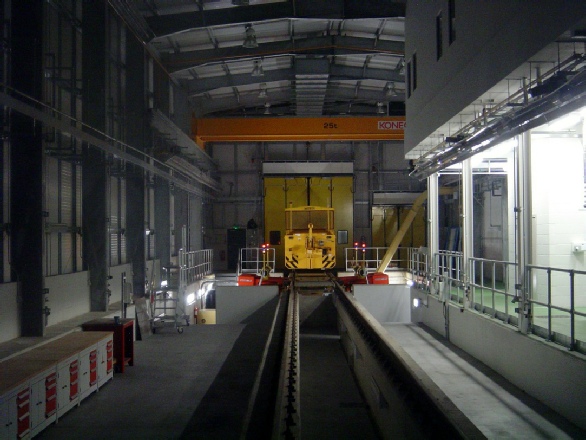
The current wheel lathe
© Stuart Smith
The capstan used to move vehicles through the wheel lathe
© Amanda Fox
The new wheel lathe building
© Amanda Fox
Finally, on behalf of all the Institution members which took part in the visit, I would like to convey a grateful thanks to all Richard Farish and all his colleagues from First Capital Connect which took time to show the Institution around the depot, answer our many questions and gave us a generous amount of time to drive the simulators. A very enjoyable and interesting evening was had by all.
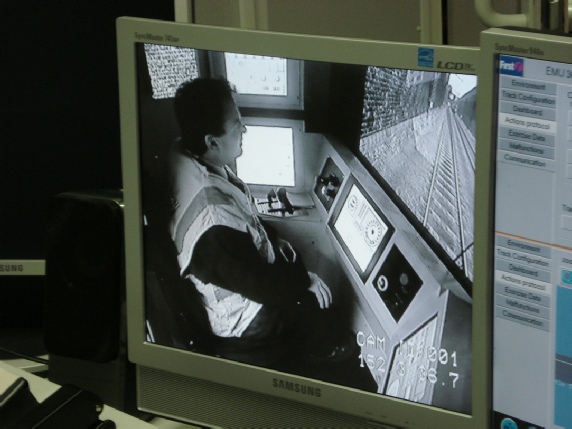
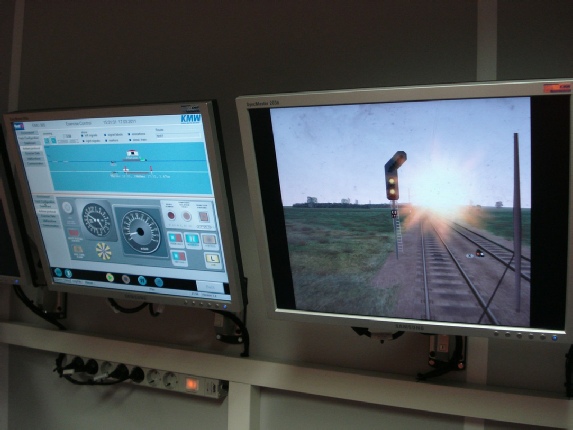
The author in the Class 365 driver simulator
© Stuart Smith
Class 365 driver simulator control desk -
© Stuart Smith